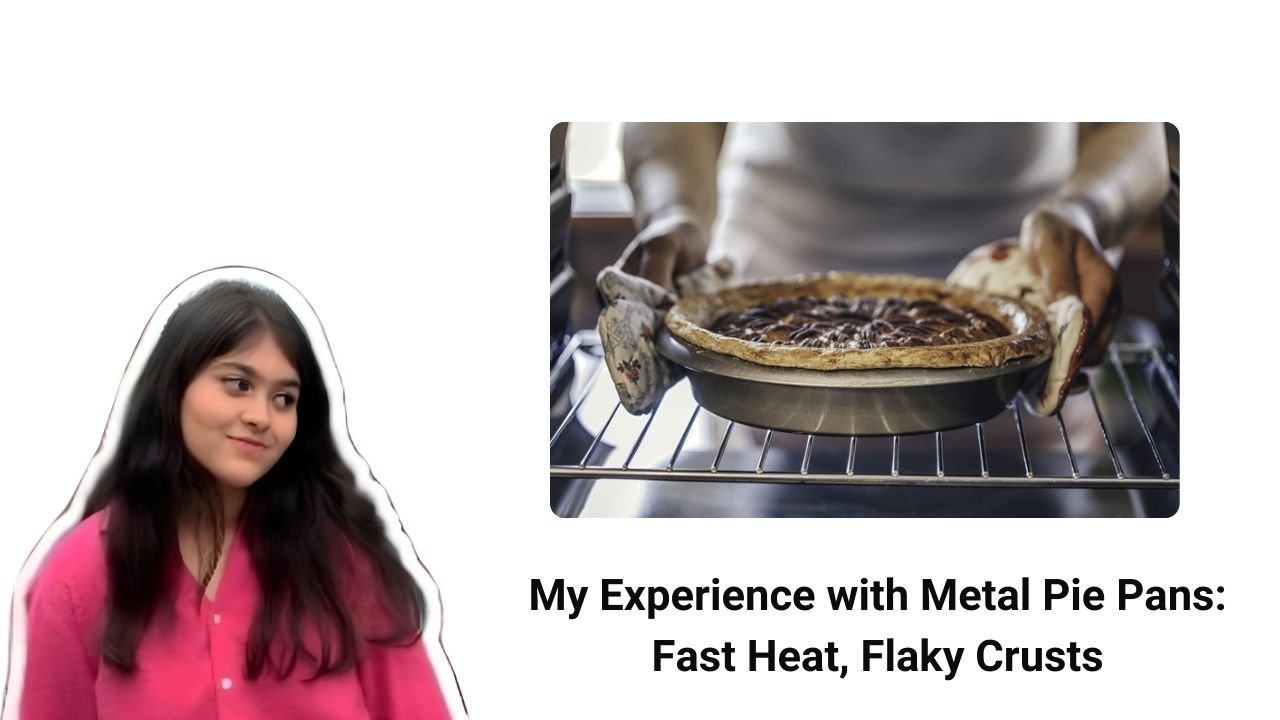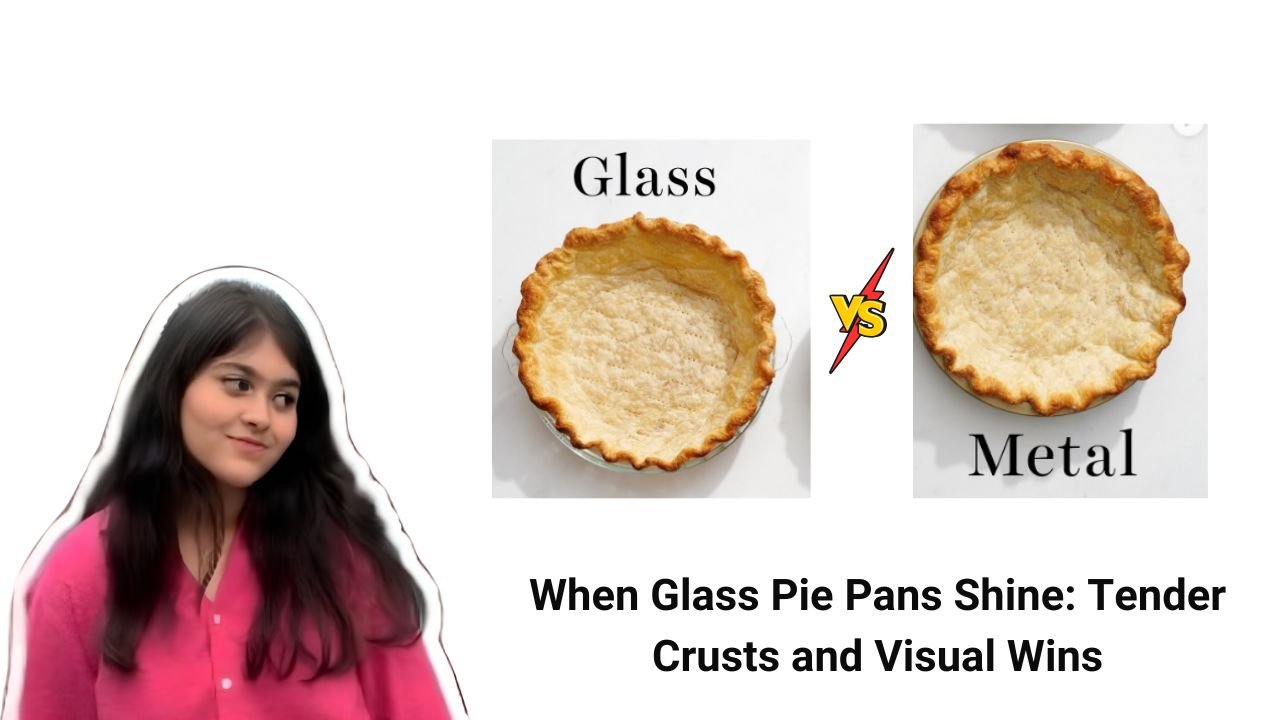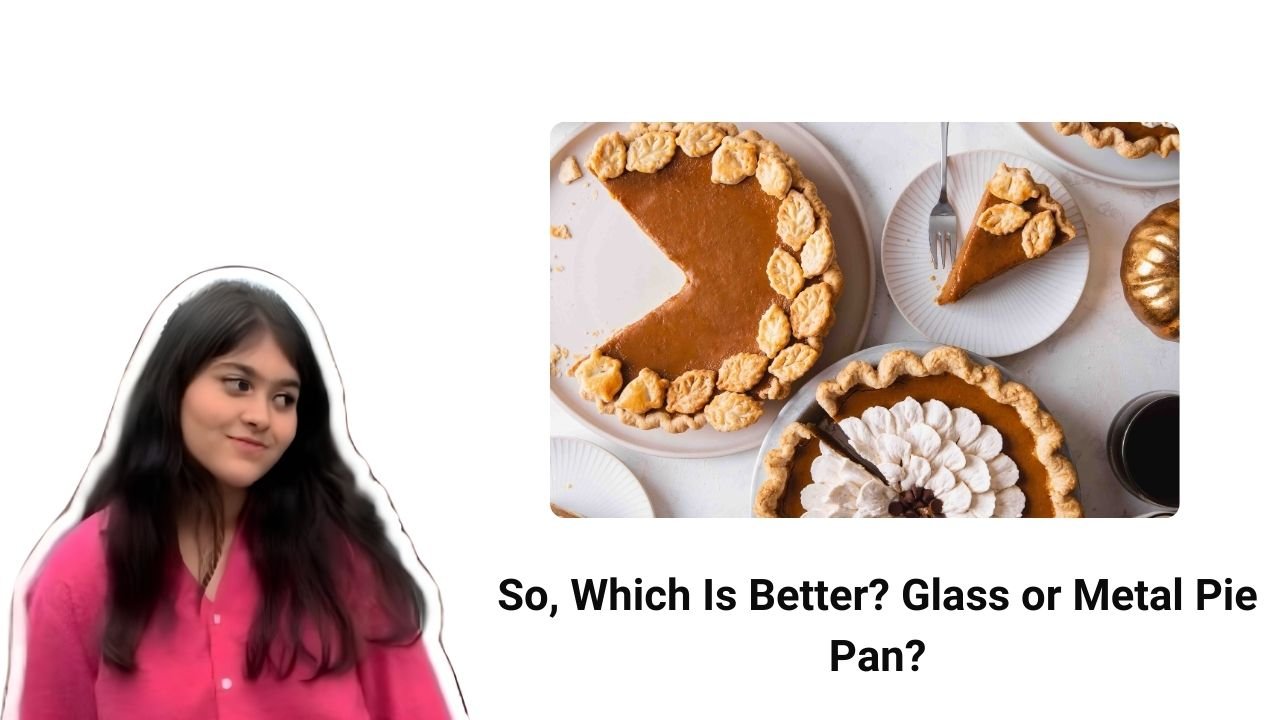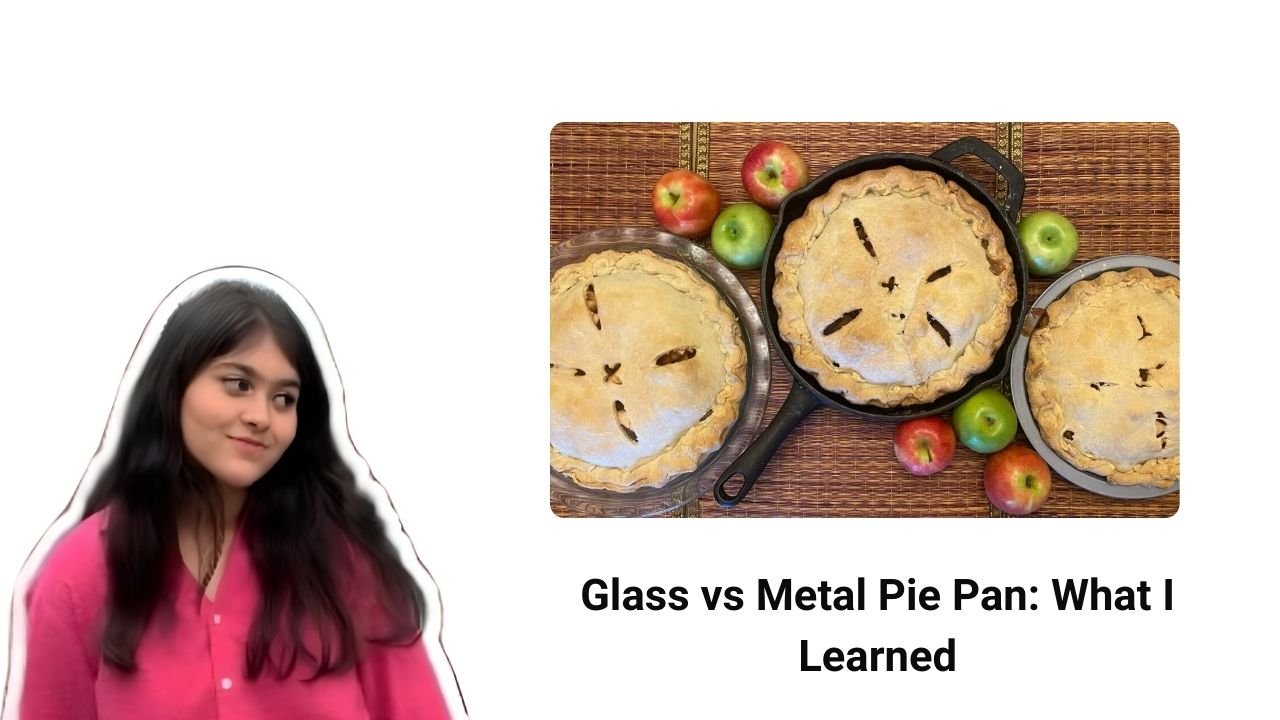When I first started baking, I thought all pie pans were created equal. Honestly, I didn’t think the dish you baked in could affect the outcome that much. But after many soggy bottoms, burnt edges, and oddly textured pies, I realized how crucial the pan material actually is. That’s when I dove headfirst into the debate: Glass vs Metal Pie Pan: What I Learned could fill a novel—but here’s the full scoop from one home baker to another.
Whether you’re making a classic apple pie or experimenting with a savory quiche, the pan you choose can either help your crust shine or leave you disappointed. Let’s break it down, starting with how each type behaves in the oven—and how that affects your final result.
Why the Pan Material Matters More Than You Think
When you bake a pie, it’s not just about flavor—texture is everything. And nothing affects that texture more than how heat moves through the pan. You might not notice it at first, but once you start comparing pies side-by-side, you’ll understand why choosing the right material is like picking the right shoes for a long hike.
Here’s what I’ve learned after using both metal and glass pans for over a year:
- Metal heats quickly and spreads heat evenly, giving the crust a golden, crispy edge.
- Glass heats slowly but holds on to that heat longer, making the crust softer but still cooked.
- Metal handles shock better (freezer to oven? No problem).
- Glass lets you peek at the bottom crust as it bakes—game changer!
It might seem like a small choice, but these differences can totally change your baking outcome. That’s why the discussion around “Glass vs metal pie pan what I learned” isn’t just trendy—it’s essential.
My Experience with Metal Pie Pans: Fast Heat, Flaky Crusts

Let’s talk about the time I tried my grandma’s pecan pie recipe in a brand-new metal pie pan. I used a standard aluminum one—not fancy, just lightweight and shiny. When I pulled it from the oven, I was amazed. The crust was crisp, golden brown, and had this perfect flake that melted in your mouth.
Why Metal Pie Pans Work So Well:
- They heat up fast, which is ideal for butter in the crust.
- That quick heat causes the butter to melt rapidly, creating steam that lifts the dough into flaky layers.
- They help the pie bake evenly, especially on the bottom where soggy crust is common.
But metal isn’t perfect. One time, I got distracted and forgot to check my lemon meringue pie until the timer went off. The crust? Borderline burnt. That’s the downside—metal doesn’t forgive you if you’re not paying attention.
Quick Pros and Cons
| Metal Pie Pans | |
| Pros | Quick heat transfer, perfect for flaky crusts, durable under temperature shifts |
| Cons | Easy to overbake crust, not ideal for slow-bake or delicate fillings |
From my experience, metal pie pans are perfect when you want a crispy crust or are working with fillings that can hold their own (think pecan, apple, or cherry). If you’re someone who struggles with soggy bottoms, metal might be your hero.
When Glass Pie Pans Shine: Tender Crusts and Visual Wins

Switching gears, let’s talk about glass pie pans. I picked up a glass pie dish with lid at a local market a few months ago, mostly because it looked pretty. But once I started using it, I noticed something very different.
My pies came out with a softer, more tender crust. Think delicate, melt-in-your-mouth texture instead of shatteringly crisp. And best of all, I could actually see through the dish to watch the crust browning.
This came in handy when I baked a sweet potato pie. Normally I struggle with judging doneness on the bottom crust, but with the glass dish, I could peek and decide if it needed more time—no guessing!
Why Glass Works for Certain Pies:
- It heats slower, which can be a blessing for creamy or custard fillings.
- It retains heat longer, helping the pie cook evenly after you take it out.
- It’s perfect for dishes where overbaking the crust is a risk.
But it’s not all sunshine. I once tried blind-baking a crust in a glass pan and took it from the freezer to the oven without thinking. Boom. It cracked. Glass can’t handle rapid temperature changes like metal does.
Glass Pan Breakdown
| Glass Pie Pans | |
| Pros | Visual monitoring, even cooking, great for slow-bake recipes |
| Cons | Slower to heat, fragile under temperature shock, crust may lack crispness |
There’s a cozy, nostalgic feeling to baking in glass pie dishes, and they really shine when the filling is the star. Think pumpkin pies, custard tarts, or even baked mac and cheese. But if you’re going for texture-forward crusts, glass might underdeliver.
Cooking Time: Glass Pie Pan vs Metal Cooking Time
One of the biggest surprises I discovered? The glass pie pan vs metal cooking time really matters. I used the same exact apple pie recipe in both pans on different weekends. The metal pan had the pie ready in 45 minutes with a crisp crust. The glass pan needed almost 10 extra minutes—and even then, the bottom was just barely golden.
So yes, the material directly affects baking time.
Side-by-Side Time Test:
| Pan Type | Cooking Time | Crust Texture | Bottom Browning |
| Metal | ~45 min | Flaky, crisp | Well browned |
| Glass | ~55 min | Tender, soft | Lightly golden |
This also means your recipe instructions might need tweaking depending on the pan you’re using. A pie baked in metal might need lower heat or less time to prevent overbrowning, while a pie in glass may benefit from starting at a higher temp for the first 10 minutes.
So, Which Is Better? Glass or Metal Pie Pan?

Ah, the million-dollar question. If you’ve been searching online or scrolling through posts labeled “Glass vs metal pie pan what I learned reddit”, you’ve probably seen opinions all over the place. Some swear by metal for flakiness. Others adore glass for its slow, even bake.
Here’s my take after many pies:
- If crust is your priority, go for metal.
- If filling and texture are your focus, or you want visual control, try glass.
- If you’re new to baking, you might want one of each to experiment and learn.
And remember, no matter the pan, your technique matters most. Chill your dough. Don’t overmix. Preheat your oven. These things count more than we think.
The Best Metal Pie Pan: My Go-To for Flaky Perfection
After testing a few, I finally found what I consider the best metal pie pan. It’s a heavy-gauge aluminized steel one with a nonstick surface. What made it stand out wasn’t just how evenly it baked, but how easy it was to remove slices without wrecking the crust.
Here’s what to look for if you’re shopping for a good metal pie pan:
- Material thickness: Thicker metal = better heat retention and durability.
- Nonstick surface: Prevents sticking and makes cleanup easier.
- Light color: Prevents over-browning. Dark metal browns faster and can burn crust edges.
- Flat edges: Makes it easier to crimp crusts without warping.
Some people love disposable aluminum pans, but I find they brown too quickly and flex too easily. Go for sturdier metal pans if you’re serious about your pies.
My Pro Tip:
Brush the bottom crust lightly with egg white before filling it. In metal pans, this creates a shield that helps prevent sogginess without altering flavor.
So if you’re aiming for restaurant-level crust texture at home, a well-made metal pie pan is a must.
Choosing the Best Pie Pan Material: Not Just About Metal or Glass
It’s tempting to boil the whole debate down to just metal vs. glass, but did you know there are other options too? If you’re a passionate baker (or plan to be), here are a few other materials you might encounter:
Quick Overview of Pie Pan Materials
| Material | Pros | Cons |
| Metal | Flaky crusts, fast baking, durable | Can burn crust, not see-through |
| Glass | Viewable crust, even heat, tender results | Slower to bake, fragile with temperature shifts |
| Ceramic | Beautiful design, holds heat like glass | Heavier, longer cook time |
| Silicone | Easy release, flexible | Doesn’t brown well, soft edges |
| Disposable Foil | Cheap, great for gifts | Thin, uneven baking, easy to dent |
That said, I always come back to the two workhorses: glass and metal. If you’re deciding between them, remember that your baking style matters more than the material. Are you the kind of person who obsesses over crust perfection? Go metal. More about slow comfort bakes? Glass will suit you better.
My Game-Changing Kitchen Hack: Glass on Metal
Now, here’s a trick I learned from a fellow baker (shoutout to the Reddit threads on “Glass vs metal pie pan what I learned reddit”) that changed everything.
I once placed my glass pie pan on a preheated metal baking sheet in the oven. The result? The crust browned like it was in a metal pan, but the gentle heat of the glass gave it a soft, custard-like consistency inside. Win-win!
This hybrid technique is perfect for:
- Custard pies (like pumpkin or buttermilk)
- Fruit pies that tend to bubble over
- Quiches where slow cooking helps avoid curdling
Sometimes, baking isn’t about choosing one side. It’s about experimenting and seeing what works for your oven, your recipes, and your taste.
Real Life: A Tale of Two Apple Pies
Let me paint a picture. It was Thanksgiving. I made two identical apple pies—one in glass, one in metal. Both were loaded with Honeycrisp apples, cinnamon, nutmeg, and just enough sugar to caramelize beautifully.
When they came out of the oven, the differences were obvious:
- The metal pie pan gave me a pie with a golden, flaky crust and crispy edges.
- The glass pie pan produced a gentler crust, slightly under-browned but soft and buttery.
The real surprise? People were split down the middle on which one they liked better. Some loved the crisp contrast in the metal pie, while others preferred the tender crust of the glass version.
Moral of the story? There’s no one-size-fits-all answer. What I learned from that day is to match the pan to the audience—and the recipe.
Glass Pie Dish With Lid: A Hidden Hero
Before we wrap up, let me give a quick shoutout to a tool that doesn’t get enough love: the glass pie dish with lid. I got one at a holiday sale, and wow—game changer.
Why? Because:
- The lid turns it into a perfect storage container (no more crust drying out in the fridge).
- It’s great for chilling dough right in the pan before baking—no need to transfer.
- It’s even good for transporting pies to parties without needing plastic wrap or foil.
Sure, it’s just a piece of bakeware, but it added so much convenience to my kitchen that I wouldn’t bake without it anymore.
If you’re someone who loves to meal-prep desserts or bring pies to family gatherings, definitely consider investing in one.
Final Thoughts: Glass vs Metal Pie Pan – What I Learned
After countless bakes, I’ve come to appreciate both pans for what they bring to the table. It’s not really about which is better, but rather which works best for the pie you’re baking.
Here’s what I’ve learned, and what I want you to remember:
- Choose metal when you want a flaky, golden crust that holds up to juicy fillings.
- Choose glass when you want gentle, slow heat and the ability to monitor your bake from below.
- Adjust your cooking time depending on the material (glass takes longer).
- Use a glass pie dish with lid for easy storage and better prep.
- Don’t be afraid to mix techniques—like placing a glass dish on a hot metal sheet!

Hey, I’m Nandoza Ahammad, passionate food enthusiast and creator of narzcookingcave.com, shares delicious recipes and cooking tips worldwide.

